 September 2015 Tank of the Month
September 2015 Tank of the Month
September 2015 Tank of the Month
Adam Sutherland's (One_Divided) 180 US-gallon Reef Aquarium
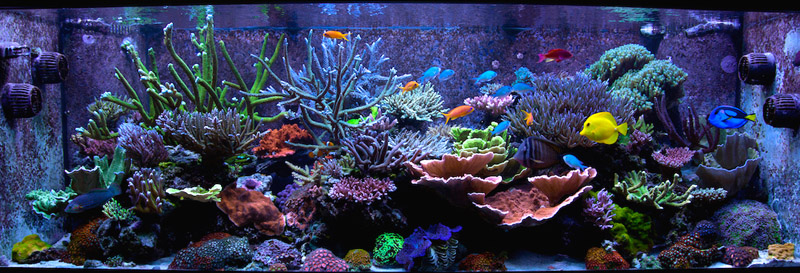 |
Introduction
When I was approached to be TOTM for September, I immediately thought, “oh no, my tank is totally not there yet!” That being said, I quickly came to the realization that I would probably never feel ready. I always think colour, growth and the layout of my rockwork can be improved, but I’ve come to realize that I am as ready as I ever will be! It is a great, great honour to be on the list amongst all of these amazing tanks from around the world. I have spent countless hours drooling over the articles and photos over the past 12 or more years.
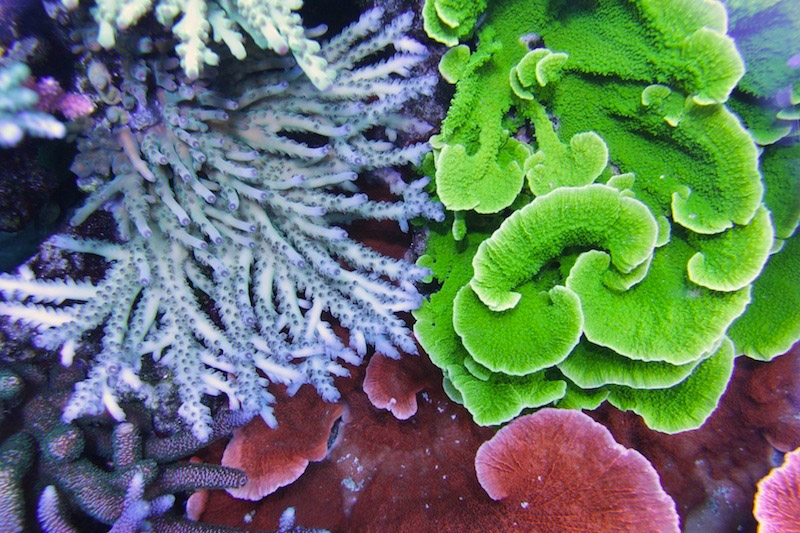 |
Background
I am a musician/music producer living in beautiful Victoria, BC Canada. I began reefing in 2001 when I was about 19 years old. Perhaps starting out young and being low on funds forced me to take my time and learn the fundamentals while I obsessed over single feather dusters and xenia polyps. It is important to take things slow; even if you have money to throw around. Aside from keeping various freshwater aquariums during my youth, I think I was especially drawn towards the saltwater hobby because I’m a bit of a control freak. What better way to satisfy the mind of an OCD control freak than to be the “god” of a small contained, ultra complex environment? Reefing was also very different from anything else I was into and seemed to balance me out. I was hooked right from the beginning and have kept a tank (or two) ever since. The first was a 33 (2001), 50 (2003), 90 (2010) and now to my 180 gallon, set up in March of 2014. I probably still have some live rock in it from my very first tank.
My tanks have pretty much always been SPS (small polyps stonies) dominated. I think I am drawn towards SPS species because of the seemly endless variations of colours and shapes and ease of fragmentation. Last year I added a frag tank to my system in order to exchange frags with other hobbyists and to help with my “ frag hoarding” problem. This has also allowed me time to further inspect for pest like AEFW (acropora eating flatworms) eggs which do not come off in dips. Also, I’m pretty sure that any hatched AEFW would have trouble surviving the ride through a filter sock, sump and past my return to the main display. I believe it is possible that one day breeding, propagation and fragmentation may be the only way our hobby can be sustained. Sharing and spreading of aquarium propagated corals will ensure survival of certain species, morphs and colour variations. I recall there was a certain piece of acropora that I purchased at one of my very first frag swaps that the owner called, “Bubblegum Acro.” I hadn’t seen it for about 10 years until earlier this year… there it was, on a fellow hobbyist’s frag rack! I bought it for $20. :)
Technical Specifications
Big surprise, another SPS tank using 400 Watt Radiums! Although LED manufacturers are making some great lights these days, I find there is still something missing for me aesthetically. I will be keeping a close eye on companies like Kessil, who utilize cluster LED technology. In my opinion, the look/shimmer of this light is the closest to that of MH’s and also that big old thing called the sun. For now, I will tolerate the exorbitant electrical costs, noisy fans and annoying yearly bulb replacements. The tank and stand were built by another hobbyest, so I cannot take credit for his fine work.
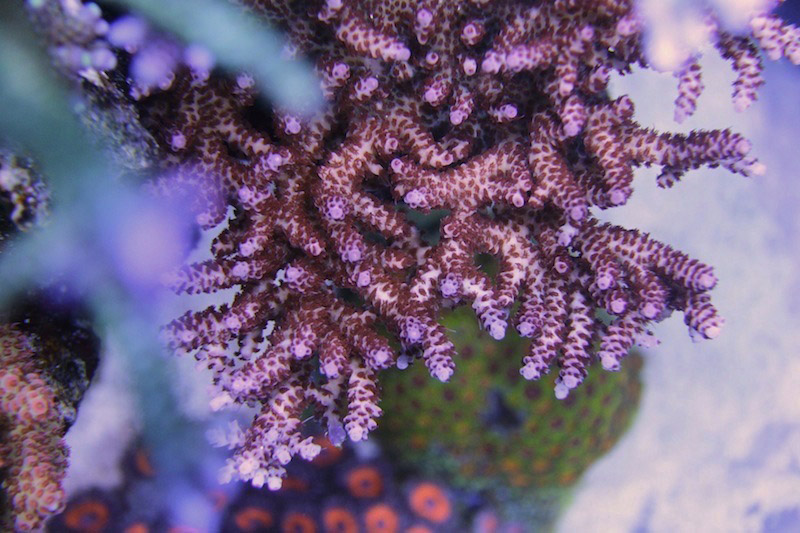 |
System Profile
• Display: All Glass Aquarium 180 US-gallons (6' x 2' x 2')
• Drain: Herbie style dual overflows (x2)
• Lighting: 400W Radiums (x3) on variable Lumatek ballasts, 80W ATI Blue Plus T5 (x4)
• Skimmer: RE Bubble King 180
• Sump: 70 gallon
• Return: Gen-x MAK 4
• Controller: Apex
• Chiller: 1/4HP Ecoplus
• Calcium Reactor: Marinetech 5-Stage Reactor (fits three containers of ARM)
• Frag Tank: 48" x 18" x 12" (plumbed into sump)
• Frag Lighting: ATI Sunpower 8 Bulb 48" ATI bulbs: B+, P+, C+, B+, B+, ABS, P+, B+)
• Return: Mag18 connected to 4-way Ocean Motions
• Powerhead: Vortech MP10ES
 |
Livestock
Fish & Invertebrates
Lyretail Anthias x5 (1 male, 4 female)
Green Chromis x7 “The Chromis Brothers”
Sailfin Tang “Dinner”
Regal Tang “Ellen”
Black and orange Ocellaris Clowns “Emo and Screamo”
6 Line Wrasse-hole “Laser Eyes”
Possum Wrasse
Melanurus Wrasse
Yellow Tang “Steve Buscemi”
Lipstick Conch x2
Various Snails x20
6” Blue Maxima Clam
Corals
My oldest colonies, like the purple acropora valida, go back to 2010 when they started as frags or small cultured colonies. I am not really sure how big some of these would be if they would never have been fragged. My Cali Tortosa colony is about 16” and the green-blue tipped stag (which has probably been reduced in half) is currently about 18”. Many others are 8-12”. I plan on removing some of these colonies once this article is out. It’s time to make room for some of the fancy frags I’ve been hoarding! I do still love the look of a huge scrolling orange monti cap though.
40+ Acropora species, including:
Cali Tortosa
Purple Valida
RR Diablo
ORA Red Planet
Tyree Pink Lemonade
RR Strawberry Shortcake
RR Blue matrix
Purple Monster (supposedly original strain)
Limeade Nasuta
RR Grape Crush
Blue/pink Prostrata
ORA Hawkins Echinata
Sarmentosa
Hyacinthus
Sunset Milepora
Loripes
Lokani
Exquisita
Crayola Plana
Nana
Caroliniana
10+ Montipora species, including:
Pokerstar
Mystic
Sunset
Setosa
many Capricornis.
Other Corals:
Pink Stylophora
Green Pocillopora
Bird of Paradise
30+ Palythoa and Zoanthid variations
Various Ricordea Shrooms
RBTA Anemone
Euphyllia Ancora
Euphyllia Paradivisa
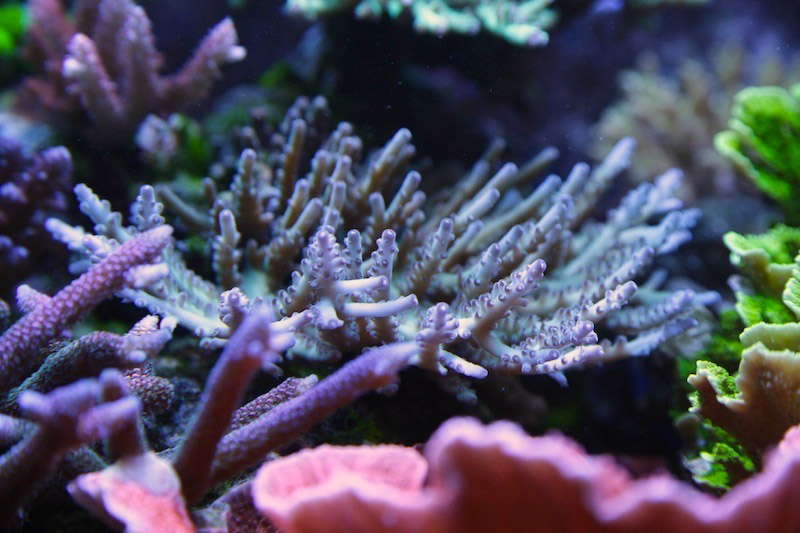 |
Parameters
Because of my massive calcium reactor, the only parameter I tend to measure regularly is Alkalinity. If my alk is sitting around 8.5-9dkh, I can be certain that CA, MG will always be in an acceptable range. I do not chase specific numbers; if the important elements are available in sufficient quantity, I believe that my corals will find them. I add a couple tablespoons of powdered potassium to my top off water (and mix with a small powerhead) from time to time. As far as other supplements, I have tried many of the well marketed products this hobby has to offer with varied or uncertain results. Sometimes things would improve or even decline, but these results could have been attributed to other factors in my tank like bacteria. I think bacteria plays a much, much larger role than a lot of people account for. It would be interesting to see if we will start testing our tanks for certain strains as reefing evolves. I am currently trying out Fauna Marin - Color Elements. My colours are improving since I began use a couple months ago. That being said, colours had been improving anyways, so it is hard to say whether or not it can be completely attributed to the additive. Perhaps I will know sometime after discontinuing for a couple months. I dose the FM at night, 2 times per week, with my skimmer turned off for a few hours (sometimes overnight).
|
Water Parameters:
|
I have found that my corals are most happy when small amounts of phosphates can be detected intermittently. That being said, in order to keep phosphates at acceptable levels and to feed as much as I like to, I dose 10-15 drops of Fozdown (lanthanum chloride) every couple of days. I prefer this method over use of GFO, which I find costly and time consuming. Fozdown also makes my water crystal clear, so now I rarely use activated carbon.
 |
Maintenance
- Water changes: every 2-3 weeks: 40-50 gallons.
- Every 2-3 months: clean/vinegar soak, then scrub wet sides of Vortechs and entire skimmer. Siphon detritus from the sump.
- Weekly: clean skimmer collection cup. Inspect all corals for signs of pests or tissue recession.
- Yearly: clean entire calcium reactor (probably should do this more often), replace bulbs (I do my MH’s and T5’s 6 months apart).
- Bi-annually: Clean/soak impellers of return pumps.
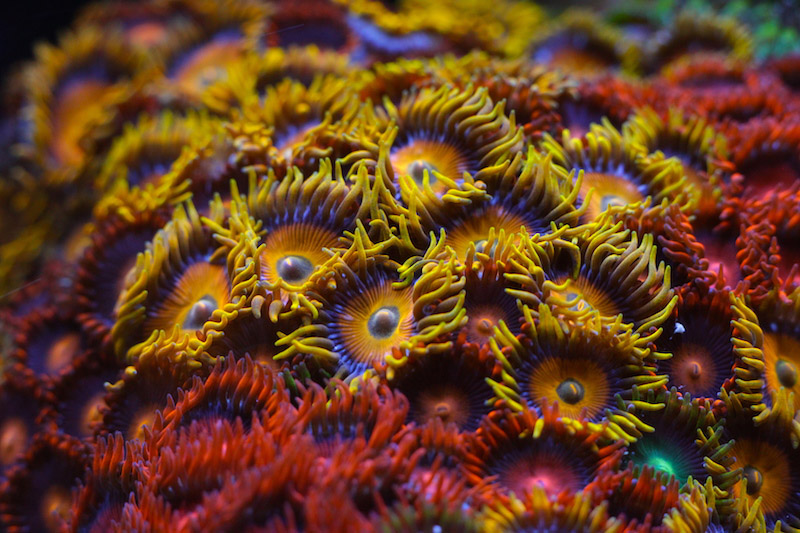 |
Feeding
I feed a 1/2-3/4” chunk of frozen plankton daily (not rinsed), pellets (small and medium) 2-3 times daily and a small sheet of nori every other day.
During the first year or my tank’s set up, despite having rapid growth on most colonies, I struggled to achieve good colouration on many of my acros. It wasn’t until I began feeding frozen plankton daily that things started to exhibit good colouration. I also noticed certain corals, which had only ever encrusted, begin to grow new axial tips. The omegas and amino acids in the plankton have completely replaced the need of costly amino acid supplements. If I discontinue feeding frozen plankton, my PO4 goes down to undetectable levels within a few days.
Tricks, Tips and Lessons Learned:
- Glue things down and let them develop a solid base. Most SPS species don’t seem to really take off until they are firmly fixed down with glue or epoxy.
- Cut non-growing axial tips of acropora. This is something I like to do on a regular basis if an axial corallite stops exhibiting growth. I have had the best results with this when cutting a branch at minimum 1/4 inch. Most staghorn type acroporids seem to have a very high success rate with this technique.
- Well distributed light from multiple angles, stable parameters and flow throughout the entire coral will yield the most natural growth formations. I’m still asking myself why I put plating Montiporas in my tank, as they always end up hitting the glass and taking up way too much real estate.
- A tank full of large growing colonies is very different than a new tank full of frags. Keep this in mind when making early decisions and looking at tanks like mine. My corals absorb a huge amount of nutrients.
- Once a tank is established, try skipping a water change from time to time. This is something I like to do every 4-5 water changes to ensure that my tank’s formula is working correctly and that enough unwanted substances are being removed via skimming/filtration. I would not recommend this for a person who’s tank struggles with high bioload/phosphates issues.
- Test every bucket of salt! I use Instant Ocean (because it’s cheap) and doctor the parameters with calcium chloride, etc. I have found that the parameters will vary from batch to batch. I recently had a bucket where the Alk tested at 12DKH. Not insanely high, but I have heard of people testing it at 16+, so take the time and always test each bucket!!!
- In my experience, the popular brand coral dips don’t always seem to work on small acropora/montipora copepods. I have witnessed them living in the slime while the coral is being dipped. The best way to be sure you won’t end up with these buggers is to give new corals a strong treatment of Interceptor or similar (I use Milbemax) which you will need to acquire from your local vet. If done correctly, this will be 100% effective in eradicating any/all crustaceans.
- Always dip/quarantine. I have had almost every classic pest in the book at some point or another. Just because something may look healthy in another person’s tank or at the local fish store, doesn’t mean it’s pest free. Beware of dips on deepwater acroporids!
- Change one thing at a time. I’ve been guilty of changing 3-4 things at once in order to correct one issue. That being said, sometimes this is unavoidable when things are going downhill fast. We’ve all done it.
- Give frags plenty of space. I have a bad habit of mounting frags too close together and letting them run into one another. I often find with SPS, there’s sort of a game of paper/rock/scissors. Or… sometimes they hit and nothing happens. I suppose I take a little morbid pleasure in seeing the results.
- Never be afraid or too proud to ask for help/advice! Even an advanced aquarist can overlook a simple issue causing a problem in their system.
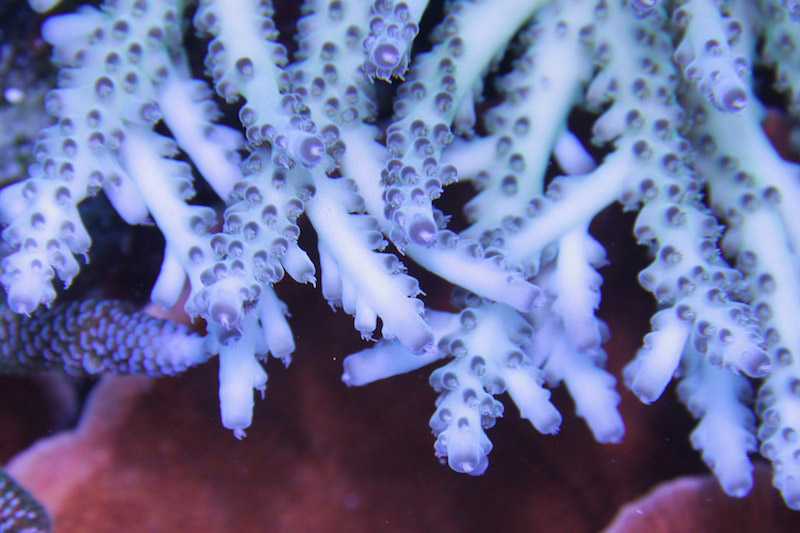 |
Acknowledgements
I would like to first thank the people in my local reef community for all of their help and support over the years. There are so many amazing and kind weirdos, like myself, that I would most likely never have crossed paths with if it weren’t for this hobby. It never ceases to amaze me how helpful people will be when you need them. I have even had complete strangers in a different city help me move a very heavy tank out of an awkward apartment just by asking for help in a local forum. Lastly, I must give a huge thank you to Reef Central/RK Magazine and its staff for allowing me to share my tank/ramblings and for running such an amazing resource. Happy reefing!
 |
Feel free to comment or ask questions about my tank in the Tank of the Month thread on Reef Central.



